7ActsMercy (original) (raw)
florin.ms app Aureo Anello AssociazioneFLORENCE AND THE SEVEN ACTS OF MERCY
A VIRTUAL & ACTUAL TOUR GUIDEThe Ordering in Time1/1. 1244, The Misericordia 2/2. 1288, Santa Maria Nuova Hospital and its Oblate 3/7. 1289, 1293, Orsanmichele 4/9. 1419, The Hospital of the Innocenti 5/6. 1442, The Buonuomini di San Martino 6/8. 1522, The Della Robbia Fountain 7/3 1786, Borgo La Croce and Piazza Beccaria 8/4. 1478, 1620, 1808, Montedomini 9/5. 1934, Giorgio La Pira's Mass for the Poor of the Republic of San Procolo 10. 1997, Progetto Agata Smeralda
The Ordering in Space
1. The Misericordia 2. Santa Maria Nuova Hospital and its Oblate 3. Borgo La Croce and Piazza Beccaria 4. Montedomini 5. Giorgio La Pira's Mass for the Poor in the Badia 6. The Buonuomini di San Martino 7. Orsanmichele 8. The Della Robbia Fountain 9. The Hospital of the Innocenti
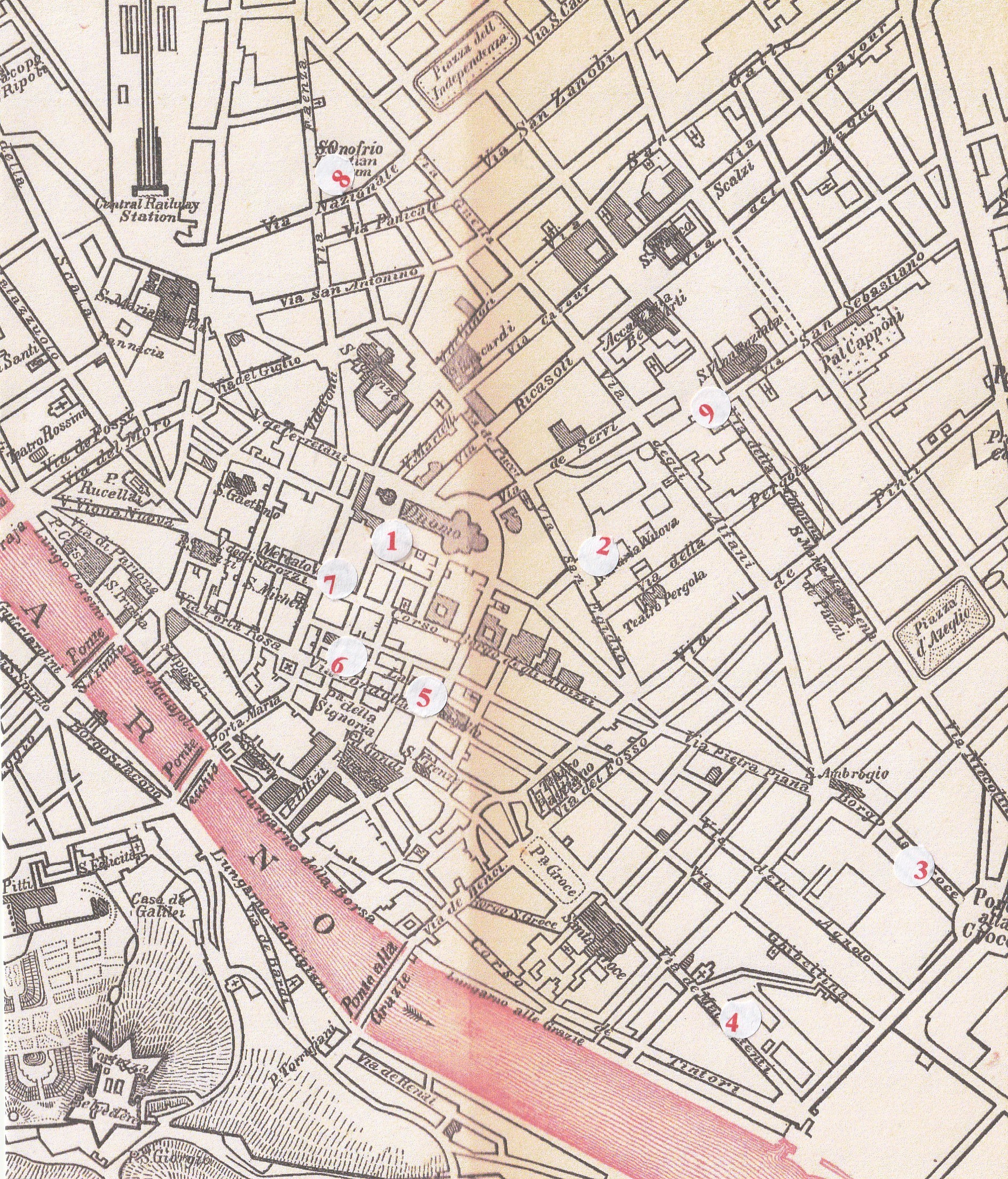
[*3] I see Florence differently than the way she is normally taught today by academics to students and by tour guides to visitors as the Renaissance starting with the Medici, with rich patrons. Instead I see her beginnings as earlier, as in the Middle Ages, where she is subsuming into herself the cities of Jerusalem, the Jerusalem Kingdom, lost in 1291, Constantinople, lost in 1453, and even, multicultural Seville in Spain where Dante's teacher, Brunetto Latino, in 1260, acquired many important Greek and Arabic works which he taught to his students, Dante Alighieri, Guido Cavalcanti and Francesco da Barberino. Above all, I see the basis of the city as the Seven Acts of Mercy from Matthew 25:
To feed the hungry
To give water to the thirsty
to clothe the naked
To shelter the homeless, the stranger, the pilgrim
To visit the sick
To visit the imprisoned, the ransom the captive
To bury the dead,
not listed in the Gospel because Christ instead said ‘Let the dead bury the dead’.
In my job as custodian I do bury the dead, their cremated ashes, in Florence’s English Cemetery.
We need to present Florence’s early history. With the Ghibelline Towers of Pride, initially, gang warfare went on between feuding families with vendettas, bloodshed in the streets, opposing those of the Guelf party who instead were merchants, and who said ‘No, this is against the common prosperity’. The Guelfs then, in 1250, had the Towers of Pride torn down and the stones next used to build the walls of common defense by Arnolfo di Cambio. They lost that power to the Ghibellines in 1260 at the Battle of Montaperti and were exiled, then returned. Next, the Guelfs themselves would split into two parties, the Blacks more aristocratically violent, the Whites, more peaceable. It’s in that milieu that Dante writes the Vita nova. In a sense, lamenting the Loss of Jerusalem, subsuming Jerusalem into Florence with Beatrice as Christ. When the Blacks seized power they in turn exiled the Whites, listing them, including Dante's name, in their Libro del Chiodo. For the context of this period it is important to read Aristotle's Ethics, included in Brunetto Latino’s Tesoro and Dino Compagni’s Cronica, and Giovanni Villani’s Nuova Cronica, which builds on the other two, and then for our time, Robert Davidsohn, whose ashes are buried here in Florence's English Cemetery owned by the Swiss. He wrote the magnificent Storia di Firenze, translated from the German, where he had studied all the documents in the archives and completely knew this period. I researched Dante’s teacher, Brunetto Latino, from their texts. This is also the time of the foundings of the Franciscan Order of Friars Minor, the Dominican Order of Preachers, and the Servites of St Mary, all of which had a great deal of influence in Florence in this time.
**1.**1244, The Misericordia. To Care for the Sick and the Dying and to Bury the Dead.

The Misericordia perhaps began in 1244. And its task, it’s the first organization we find, is to bury the dead, which was not in the Gospel. The magnificent later painting which is now in the building known as the Bigallo but which was then part of the Misericordia, has the Madonna of the Misericordia, of Mercy, with the Tau cross on her crown, painted in red, the red blood of the Pascal Lamb, the Angel of Death passing over the houses that had that symbol of the Hebrew slaves in Egypt. And the crown of the Madonna is Matilda of Tuscany’s crown. And then you see the roundels: of Hunger and Thirst, the Stranger, the Naked, the Sick, the Prisoner, God’s Mercy being for all. And then the men and women and last the city of Florence beneath her feet, her cloak.
And this is the Latin text.

And also on the side you get the Catechism and the Sacraments. It’s a teaching text.

11 September 1342
In 1961, I was in the Duomo where, at that point, the Michelangelo Pietà still stood, in situ as Michelangelo intended, while the priest was preaching against the film, La Dolce Vita. And I was sketching the Pietà. Michelangelo puts his own self-portrait into the face of Joseph of Arimathea as a Misericordia worker with the black hood, the task being to bury the dead, here the dead Christ, our humanity.


And these are the Misericordia workers through time. I still saw the Misericordia members in these black hoods like the Ku Klux Klan, who were to care anonymously for the sick and dying – and still do. But now in modern uniforms.


And then I found this painting. This is of a seventeenth-century plague in Florence. You see the workers taking the sick and the dying. It’s before the modern façade – the Arnolfo di Cambio one has already been removed but the new one we have today which was partly built paid for by the Swiss banker Wagnière, buried in our cemetery, is not there yet.

And then these are the ambulances outside by the Duomo, still functioning, free, which is a magnificent seven-hundred-year old heritage in Florence.

2. 1288, The Santa Maria Nuova Hospital. To Visit the Sick
The Ospedale di Santa Maria Nuova, founded in 1288. This is for Visiting the Sick Folco Portinari, the rich banker began the hospital at the insistence of Monna Tessa, who was Beatrice’s Nurse and she founded the Order of the Oblate, women who would take care of the cleanliness of the hospital. In 1290 Beatrice Portinari, married at that point, dies, perhaps following childbirth. And the following years is the Fall of the Jerusalem Kingdom, which Dante is discussing in part obliquely in the Vita nova. In 1300 he would become Prior and in 1302 he will be in exile.
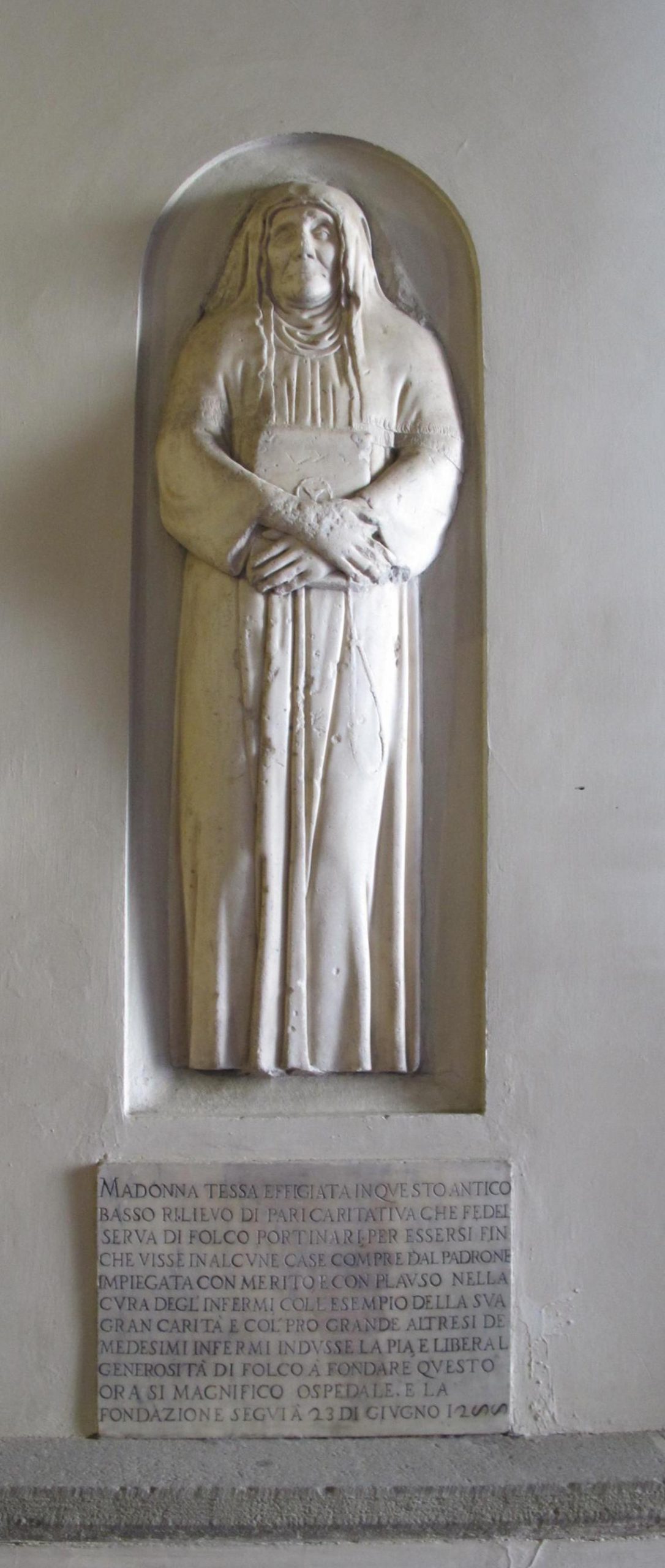

Monna Tessa, founder of the hospital Sarah Parker Remond, Afro-American Aboltionist, studied
medicine at Santa Maria Nuova Hospital 600 years later
This is what the hospital looked like when Pope Martin V blessed it

And this is a reconstruction of it with the church of Sant’Egidio in the centre of it.

And this is the way it looked in the Seventeenth Century.

And as it still does today

It’s a huge complex, taking up a large space in Florence and is filled with art treasures.
These are pottery shards we find buried in the English Cemetery.
The pieces with the T on them is of the crutch, the emblem for Santa Maria Nuova Hospital, which also symbolizes the Tau we have already seen on the crown the Madonna wears in the Misericordia Bigallo fresco .
 These – this task of creating from clay, firing it with glazes, following from the Etruscans, was especially carried out by the Della Robbia family. And this was made for the Ospedale di Santa Maria Nuova with the dead body of Christ on the lap of Mary. This is where Michelangelo and Leonardo studied anatomy using the corpses of the dead.
These – this task of creating from clay, firing it with glazes, following from the Etruscans, was especially carried out by the Della Robbia family. And this was made for the Ospedale di Santa Maria Nuova with the dead body of Christ on the lap of Mary. This is where Michelangelo and Leonardo studied anatomy using the corpses of the dead.

And this is the painting that Tommaso Portinari, the descendant of Folco Portinari, commissioned of Hugo van der Goes in Bruges, where he was part of the banking establishment which had a network all over Europe and also in Africa and the Near East. We have this painting created for Santa Maria Nuova for the church of Sant’Egidio in the centre of it in 1475. Now it is no longer_in situ_. It’s in the Uffizi.

But we see the baby lying naked on the ground. This is Jesus, but this is also us, needing care by the community. This follows on Matthew 25: ‘When I was thirsty, did you give me drink? When I was hungry, did you feed me? When I was naked, did you clothe me?’ It is also the result of Saint Birgitta of Sweden's vision in the cave in Bethlehem where she sees Mary give birth, laying her newborn on the ground, proclaiming him her Lord and Creator, the Madonna in Humility theme taken up by artists everywhere following the publication of her Book of Revelations.
3. 1786,Borgo La Croce and Piazza Beccaria
In Borgo La Croce we find this frescoed tabernacle of Christ on the Cross and Mary his mother both leaning towards the persons being conveyed down that street to their executions at the Porta La Croce, in Piazza Beccaria. Tuscany abolished capital punishment in 1786, following the publication of Cesare Beccaria's _On Crime and Punishment_in 1764. Russia did the same, exiling its criminals instead to Siberia, about which Fedor Dosteivsky wrote in _Crime and Punishm_ent. Doseivsky wrote part of his Idiot in the Piazza Pitti near Elizabeth Barrett Browning's Casa Guidi. The fresco is protected with glass which reflects the shutters of the building opposite, called 'persiane' in Italian as this concept of 'air conditioning' of allowing air but not sunlight in when it is hot came from Persia, from Iran.

4. 1478, 1620, 1808, Montedomini
Near here is the Montedomini complex which houses the indigent elderly Florentines, an edifice expanded during Napoleonic times


5. 1934, Giorgio La Pira and Fioretta Mazzei's Mass for the Poor in the Badia Fiorentina
This was begun by Giorgio La Pira, the saintly Mayor of Florence, as the Repubblica of San Procolo where he gathered the indigent, sleeping under bridges, etc., and had them tell him how to govern Florence, and continued by Fioretta Mazzei at his death.. It still continues, now in the church of the Badia monastery by Dante's house, meeting for Mass on Sunday mornings at 9,00 p.m.


Giorgio La Pira and Fioretta Mazzei
6. 1442, The Buonuomini of San Martino
Opposite Dante's house and by the Torre della Castagna is the small church of San Martino, possibly founded by Irish pilgrim monks. In 1442 Florence's Bishop Antonino founded the Buonuomini di San Martini giving them this church for their chapel. It has the Seven Acts of Mercy painted around it by Domenico Ghirlandaio, repeating those we have already seen in the Misericordia. There are two slots, one in marble for letters, 'Per le Istanze', where some one of the 'proud poor' needs to be helped, who must be Florentine, the other in iron with a cross for money. Each Friday the 12 Buonuomini meet as they have done now for centuries, and share the money amongst the requests, The group owns only the chapel and the strong box

Per le istanze Elemosine

And it describes inside here the vision of the story of Saint Martin who is the Roman soldier who must not give away his mantle and sword, but who cuts with his sword his soldier’s cloak in half. Cloaks are very important in the story. It can be Saint Mary’s cloak, it can be Saint Martin’s cloak. And then, dreaming, he has the vision of Christ coming to him and saying ‘I was the naked beggar whom you clothed’, himself wearing that Roman army cloak.


And then you have the Drink to the Thirsty,

You have Clothing the Naked

you have the Lodging for the Pilgrim, with this wonderful detail of the glasses and the pottery, which is like the pottery we find in the English Cemetery. and Visiting the Sick. Here a mother with her baby following childbirth, a concern Florence will continue through time as we see in the Galileo Museum and La Specola with its wax models of childbirthing problems which Sarah Parker Remond, the Afro-American Abolitionist will study at Santa Maria Nuova Hospital in 1866-1868 with a letter from Giuseppe Mazzini, her plaque to be placed beside Monna Tessa's effigy there.
and Visiting the Sick. Here a mother with her baby following childbirth, a concern Florence will continue through time as we see in the Galileo Museum and La Specola with its wax models of childbirthing problems which Sarah Parker Remond, the Afro-American Abolitionist will study at Santa Maria Nuova Hospital in 1866-1868 with a letter from Giuseppe Mazzini, her plaque to be placed beside Monna Tessa's effigy there.


And here Ransoming the Prisoner, even from Florence’s near-by Stinche. You had already in Giovanni Villani the dreadful story of Corso Donati liberating all of the prisoners but it was to have them support him gain power which was not really according to Justice. You have Dino Compagni and Giovanni Villani speaking of Corso Donati as a new Catiline, betraying Florence just as Catiline sought to betray Rome.
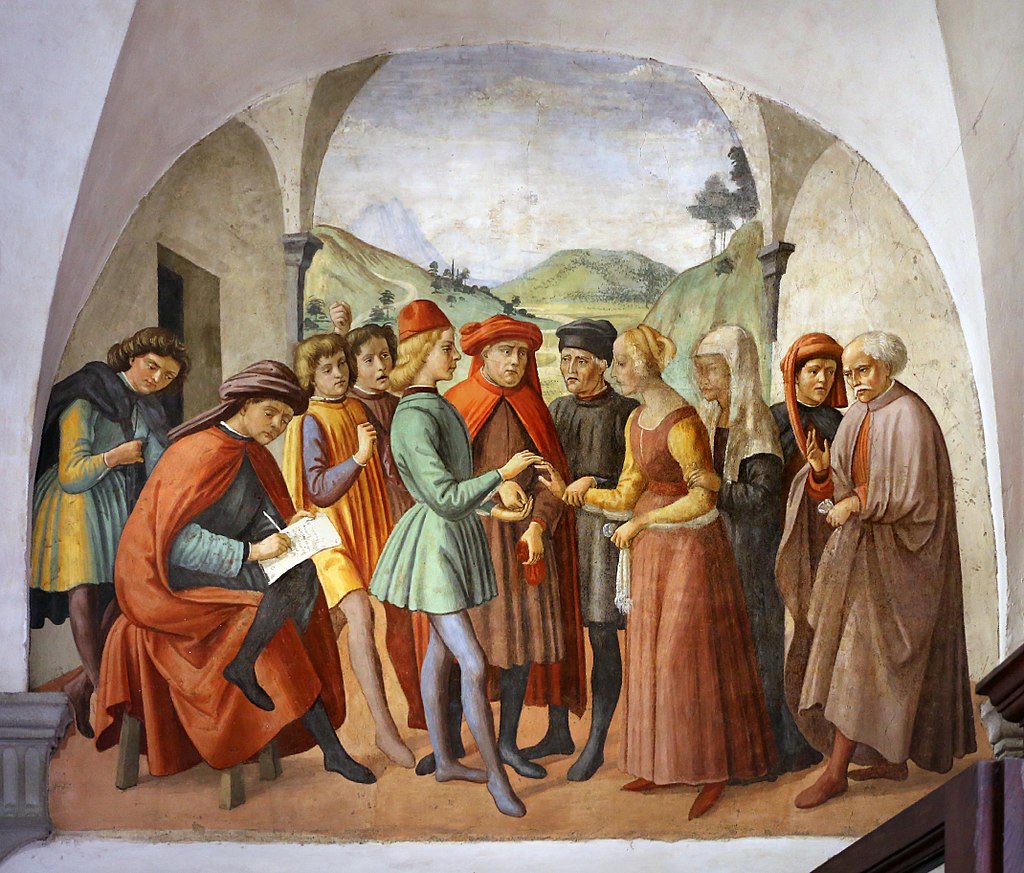
And here is a marriage with the notaio making sure that the correct dowry is recorded.
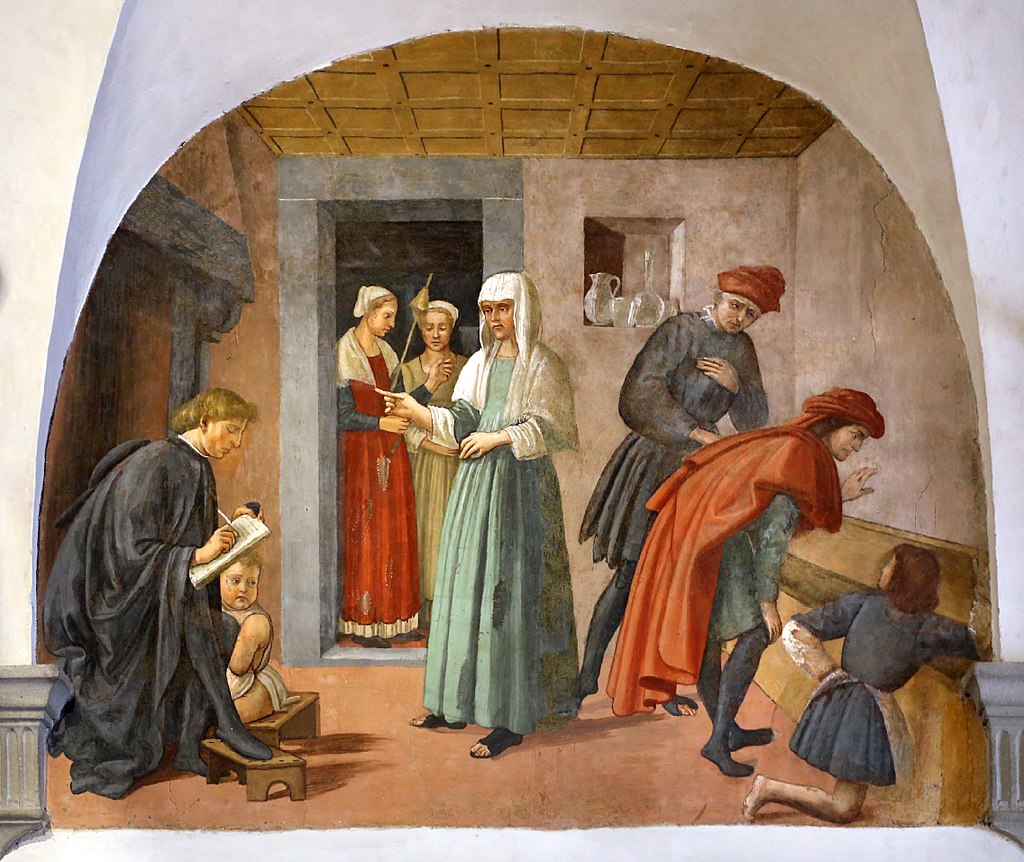
And also at the time of death the inventory of the possessions, with the widow and children that are going to be cared for.

And here you see the Burial of the Dead in the Jewish fashion with the sheet, the shroud, sewn round the body laid in the ground.
This is the time of Savonarola, who was surrounded by artists, telling them not to paint their mistresses as the Madonna but to find a pure young girl and she would be more beautiful. This is Luca Della Robbia’s magnificent Visitation, of the young pregnant unwed mother Mary being greeted by the priestly elderly pregnant Elizabeth. It’s a most beautiful sculpture in terra cotta.

One of the things that the Florentines were able to do was to use the cheapest materials, like the clay of the earth, and create absolutely exquisite beauty from it.
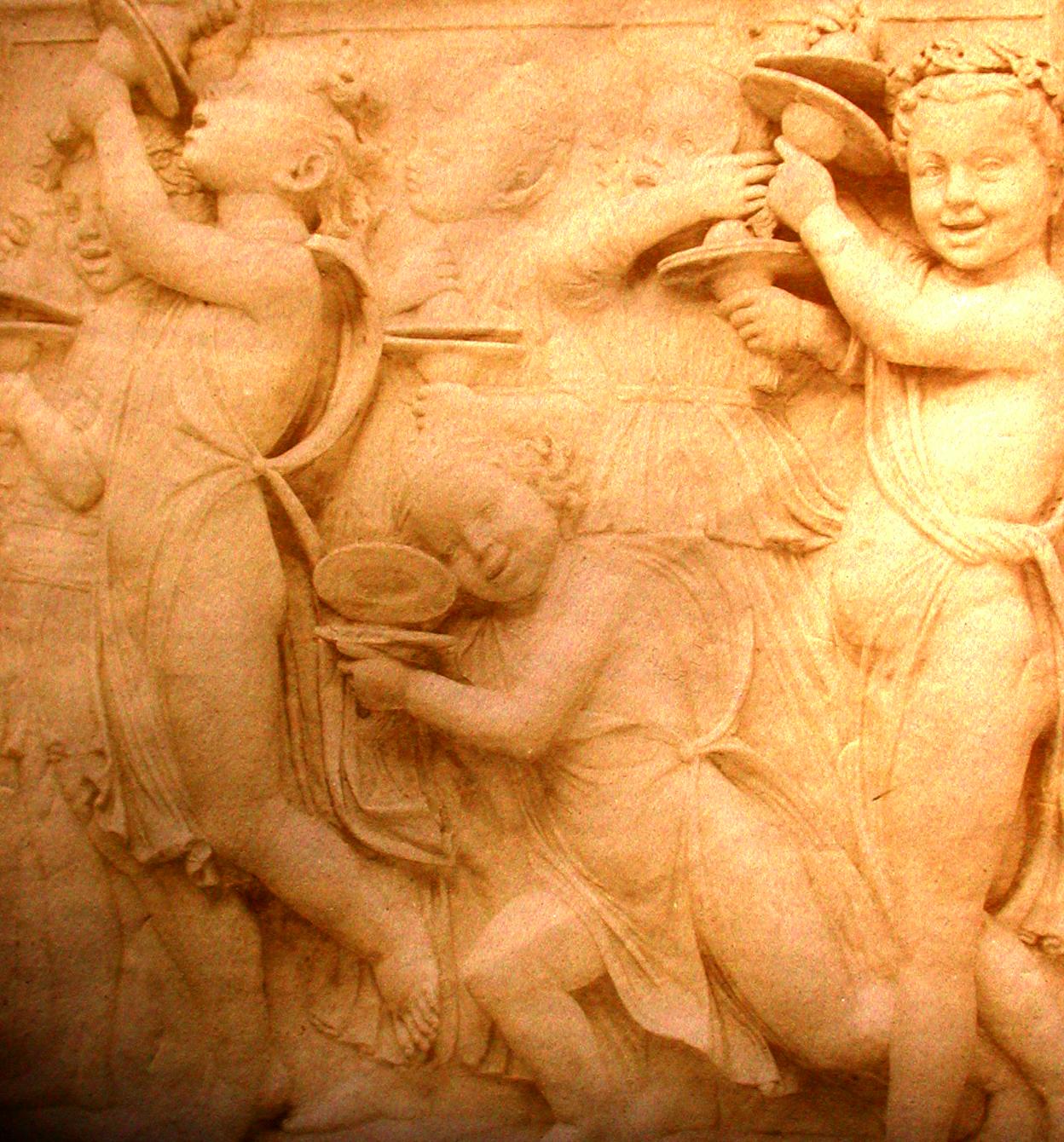
Up here is the choir frieze done by Luca Della Robbia.
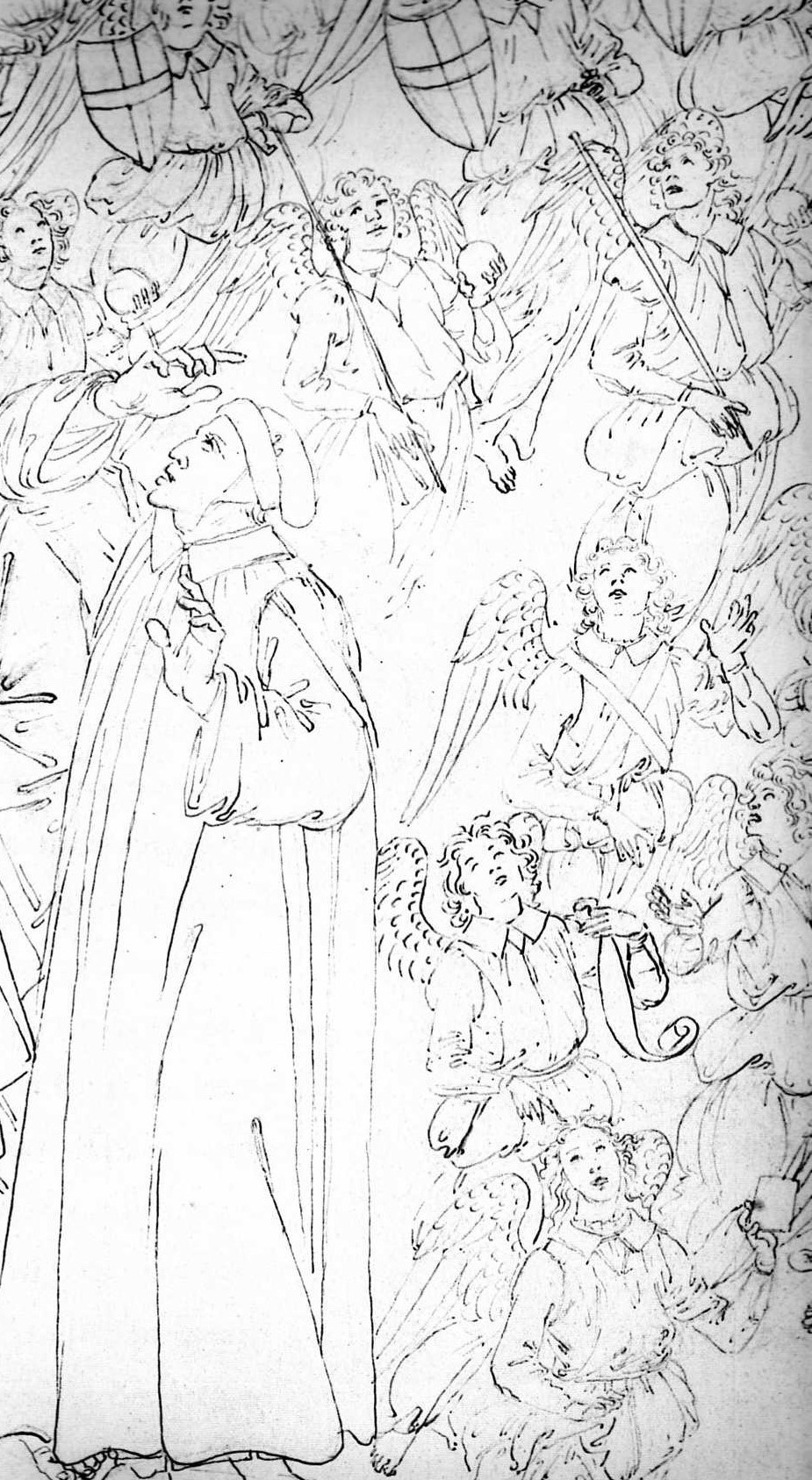
And here I show that Botticelli’s angels in Dante’s Paradiso are the boys Savonarola had going around the households collecting up all of the Vanities, false hair, cosmetics, false padding and so on, which George Eliot will also describe in her novel, Romola.
7. 1289. 1293, Orsanmichele and its Compagnia dei laudesi
Orsanmichele is our next institution. It is built in 1289 by Arnolfo di Cambio, destroyed in a fire in 1304, rebuilt, 1336. And it was to feed the hungry. It was a great granary. It has three floors, a huge building, amazing engineering for when it was created. It was almost destroyed at the Risorgimento and I am so glad it was not. And right from the start there had been this miraculous image of Mary and the Child. And both the Hospital of Santa Maria Nuova’s parish of Sant’Egidio and Orsanmichele had groups that formed around them that would come together and sing, the Compagnie dei Laudesi, singing Franciscan laudas, lighting many candles, meeting together for Mass. And this, in a sense, is the glue of the city. The members of this Compagnia dei Laudesi, would be buried near the Duomo, in the Piazza San Giovanni, which was then also a cemetery.
In 1289 Ugolino della Gherardesca and his children died in prison and it was seen that he had cannibalized his children. Florence felt awful about this because they had created this blocade, had forbidden any food stuffs going to Pisa. So the people who were starving, in their revenge punished Ugolino so that he would also starve. And when this was discovered the Florentines in reparations built Orsanmichele, which was to feed even the enemy in time of famine, the Pisans, the Sienese and so forth. In 1296 Arnolfo di Cambio builds the Duomo. In 1300 Dante when Prior in the Torre della Castagna had to exile Guido Cavalcanti because he was feuding with Corso Donati, which was not allowed under the Guelf Ordinaments of Justice, and as a result Guido died of malarial fever. And then Dante himself would die of that mosquito born disease in 1321, after writing the Commedia.
Guido Cavalcanti before his death had written this sonnet about Orsanmichele, saying how wonderful it is that this lay people’s construction, it’s not by the Church, it’s not by the Franciscans or the Dominicans, nor the Curia, it was by the lay Guilds, and each had contributed wonderful statues, paintings and so forth, and they maintained it. And so many miracles happened around the figure of the Madonna. This photograph I took many years ago, when Orsanmichele was still very dirty and it was marvellously holy.

When they cleaned it up it lost that sense.
But here is this splendid huge building of seven centuries ago.
 And this is the book which the King of Spain, of Castille, Alfonso X el Sabio, gave to Brunetto Latino, to Florence, Las Cantigas de Santa Maria, with all of the miracles of the Virgin. And in each of these pages she is shown in a tabernacle, which is copied at Orsanmichele.
And this is the book which the King of Spain, of Castille, Alfonso X el Sabio, gave to Brunetto Latino, to Florence, Las Cantigas de Santa Maria, with all of the miracles of the Virgin. And in each of these pages she is shown in a tabernacle, which is copied at Orsanmichele. This miniature shows the previous image before the fire from the Libro del Badiaiolo.
This miniature shows the previous image before the fire from the Libro del Badiaiolo.

And here you can see how beautiful the Madonna and Child are in the Orcagna tabernacle.
 And this is the second floor. The grain was stored in these two upper floors and sent down in chutes to the ground floor where needed. Here are the figures now placed indoors with copies outdoors of the various saints protecting Florence. I don’t have a photograph of the third which is absolutely marvellous with a view all around Florence. You get to these other two floors by going to the next building, on Mondays, climbing its stairs and crossing over on a bridge between the two buildings.
And this is the second floor. The grain was stored in these two upper floors and sent down in chutes to the ground floor where needed. Here are the figures now placed indoors with copies outdoors of the various saints protecting Florence. I don’t have a photograph of the third which is absolutely marvellous with a view all around Florence. You get to these other two floors by going to the next building, on Mondays, climbing its stairs and crossing over on a bridge between the two buildings.

This is the only bulding for the Seven Acts of Mercy that is no longer used for its original purpose in Florence. But it was so loved by the laity that Guido Cavalcanti who lived nearby wrote the sonnet praising its miracles, he and Brunetto Latino being buried amongst the Companions of the Compagnie dei laudesi di Orsanmichele, Brunetto Latino's daughter leaving her wealth to it, the Compagnia dei Laudesi di Orsanmichele sending Boccaccio to Ravenna to give Dante's daughter, become a nun and taking the name 'Beatrice', five gold florins, and Pietro Alighieri leaving his father's house to the Compagnia dei Laudesi di Orsanmichele.
8. 1522, The Della Robbia Fountain. To Give Drink to the Thirsty
This is the fountain by the third generation of the Della Robbias, Giovanni Della Robbia, who uses lots of colour, and it’s a public fountain giving Drink to the Thirsty. When a few years ago two Roma women washed their hair and clothes here, they were photographed by a journalist, it was published in a newspaper, and all Florence was furious: ‘How could those filthy Roma women dare go near this beautiful work of art’. But actually this work of art was created precisely for that purpose, to give Drink to the Thirsty, cleanliness to those who need it, then and now.


9. 1419, The Hospital of the Innocenti. To Care for the Orphans
And then we come to the Ospedale degli Innocenti, in 1419, built by Brunelleschi. And this is not in the actual Acts of Mercy, but it is the caring of the orphan. Instead of killing the babies which couldn’t be supported out of poverty, they could be carried to the Ospedale degli Innocenti where they were raised by the wealthy Guild of the Arte delle Sete, of the Silk Guild, and were given, if they are a boy, a trade, a skill, and if they were a girl, a dowry.
And all of this follows on from the Franciscans and the Servites, as the Ospedale is right next to the church of the Santissima Annunziata. This was the Order founded by seven rich young men who went up to a cave in the mountains in Monte Sennario and had a vision of the Virgin, gave up their wealth to live the life of prayer and charity. And then in 1436 you will have Brunelleschi – this was done when he was quite young – finish the dome of the Duomo. And then later you will have the Council of Florence in 1439, with the Greeks coming, Cardinal Bessarion among them bringing manuscripts from Trebizond and Constantinople to Florence, Rome and Venice. Next, with the loss of Constantinople in 1453, Florence and Venice will be the main heirs of Constantinople's splendid intellectual wealth.
Here is the square of the Santissima with the Ospedale.

And with the wonderful medallions of babies in fasces by the Della Robbia. In the Sixties in Italy I still saw babies like this.

And this is the boys’ cloister.

The girls’ cloister is smaller, I’m afraid. We always get the short end of the stick.

And then here is the painting by Domenico Ghirlandaio again, this time for the children in the orphanage and you can see the two Innocenti boys building the stable for this family who are so poor, that the baby is born naked in the stable. And here you get the rich men who are giving their wealth to build this hospital, their portraits, including the portrait of the artist among them. And then this view is probably of the Arno going up to Compiobbe. There’s this way in Florentine art of making the Gospel be here and now in this moment in Florence, collapsing time and space, because she is creating a new Jerusalem.

10. The Certosa
Beyond Florence is the Certosa that Nicolò Acciaiuoli built with his ill-gotten wealth, gained from Naples and all the various colonies left behind by the Crusaders because the Kings and Queens of Naples were also Kings and Queens of Jerusalem. Even though Jerusalem was lost, there were still quite a lot of possessions.
And when Nicolò Acciaiuoli is dying in Naples, Birgitta, at his death bed, has this tremendous vision saying his soul is almost lost. But the Virgin has all of the Carthusian monks of the Certosa praying for him under her cloak. And this goes right back to the
the paintings of the Servites of Santa Maria's Madonna sheltering all under her cloak, the Madonna della Misericordia with the Seven Acts of Mercy, the painting of the Madonna della Misericordia of the Innocenti sheltering the orphans, also the paintings of the same theme by Simone Martini and Piero della Francesca, and Brunelleschi’s dome of Santa Maria del Fiore specifically built to shelter and nurture all Florentines under it.

The Madonna of Mercy, Misericordia The Madonna of Mercy of the Innocenti Orphans

Florence's Cathedral at night
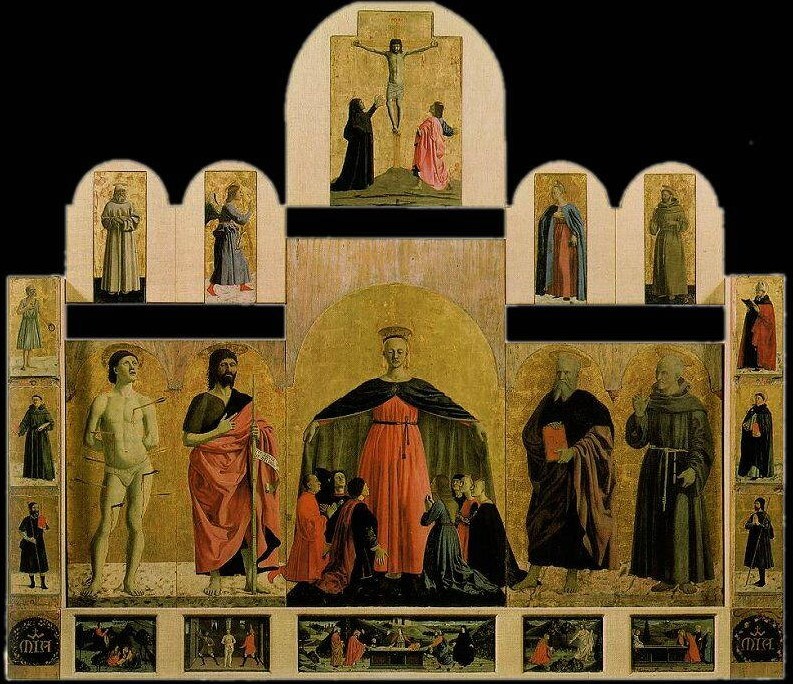
Piero della Francesca, Madonna of Mercy, on the left the naked St Sebastian with arrows, patron saint against plague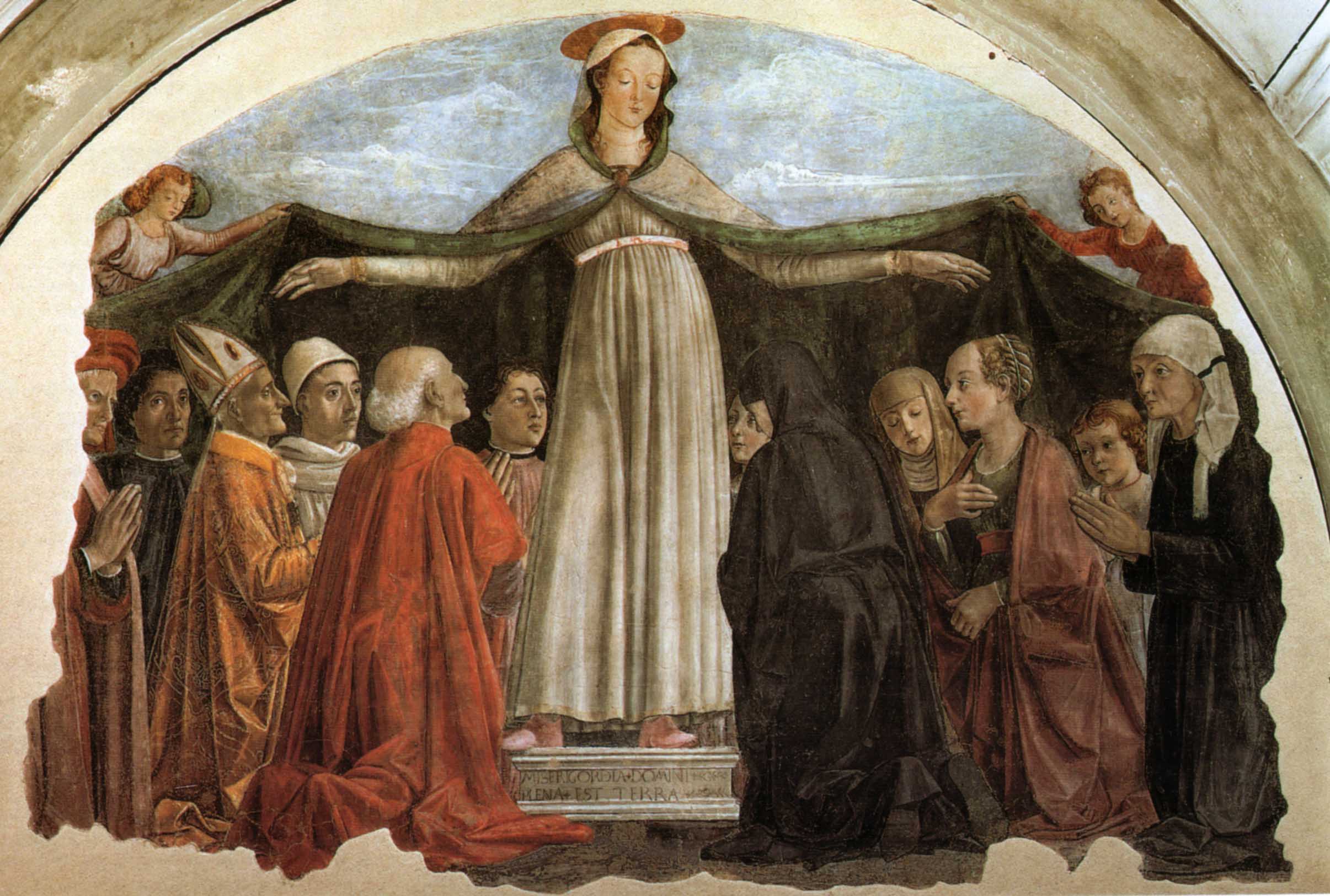
Domenico Ghirlandaio, Madonna of Mercy, Ognissanti, Florence, with portraits of the Vespucci family, Amerigo to the left, Simonetta to the right of the Madonna.
11. Agata Smeralda and Florence's English Cemetery. Professor Mauro Barsi, founder of the Progetto Agata Smeralda which raises funds for Third World orphanages, heard my argument that we need to preserve families with children so that ancestral skills can continue to be taught parent to child, blacksmithing, stonemasonry, carpentry, gardening, sewing, cooking, cleaning, all of which he Romanian Roma families who restore the English Cemetery know, and he has helped us with funding for their schooling in literacy as well for I found these European Citizens had not even been taught how to sign their own names or the alphabet. Our Roma families have restored Florence's anti-slavery cemetery and are now literate as well.
Matthew 6. 19. Lay not up for yourselves treasures upon earth, where moth and rust doth corrupt, and where thieves break through and steal: 20. But lay up for yourselves treasures in heaven, where neither moth nor rust doth corrupt, and where thieves do not break through nor steal: 21. For where your treasure is, there will your heart be also.
Dante Alighieri, Girolamo Savonarola, Elizabeth Barrett Browning and Giorgio La Pira all saw Florence as potentially a new Jerusalem. It's not money, but knowledge, it's the Seven Acts of Mercy, that made her beautiful
For other Florence guides/Per altre guide di Firenze: https://www.florin.ms/GoldenRingGuides.html
****FLORIN WEBSITE A WEBSITE ON FLORENCE © JULIA BOLTON HOLLOWAY, AUREO ANELLO ASSOCIAZIONE, 1997-2022: ACADEMIA BESSARION || MEDIEVAL: BRUNETTO LATINO, DANTE ALIGHIERI, SWEET NEW STYLE: BRUNETTO LATINO, DANTE ALIGHIERI, & GEOFFREY CHAUCER || VICTORIAN : WHITE SILENCE: FLORENCE'S 'ENGLISH' CEMETERY || ELIZABETH BARRETT BROWNING || WALTER SAVAGE LANDOR || FRANCES TROLLOPE || ABOLITION OF SLAVERY || FLORENCE IN SEPIA || CITY AND BOOK CONFERENCE PROCEEDINGS I, II, III,IV,V,VI,VII , VIII,IX,X || MEDIATHECA 'FIORETTA MAZZEI' || EDITRICEAUREO ANELLO CATALOGUE || UMILTA WEBSITE || LINGUE/LANGUAGES: ITALIANO,ENGLISH || VITA** New: Opere Brunetto Latino || Dante vivo || White Silence